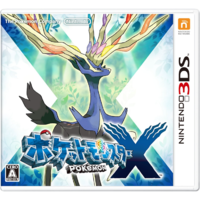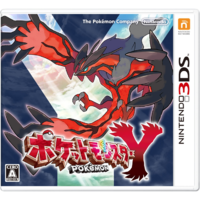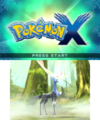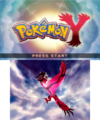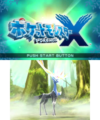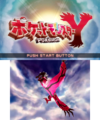Pokémon X and Y
- X & Y redirects here. For other uses, see XY.
- Pokémon X redirects here. For other uses, see Pokémon X (disambiguation).
| Pokémon X ポケットモンスターX | |
|---|---|
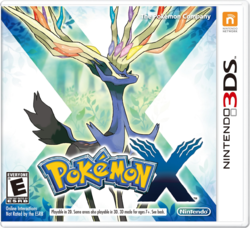 Pokémon X's boxart, featuring Xerneas | |
| Pokémon Y ポケットモンスターY | |
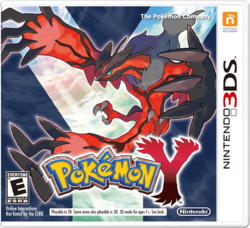 Pokémon Y's boxart, featuring Yveltal | |
Basic info
| |
| Platform: | Nintendo 3DS |
| Category: | RPG |
| Players: | 1-4 players simultaneous |
| Connectivity: | 3DS Wireless, StreetPass, SpotPass, Nintendo Network, IR |
| Developer: | Game Freak |
| Publisher: | Nintendo/The Pokémon Company |
| Part of: | Generation VI core series |
Ratings
| |
| CERO: | A |
| ESRB: | E |
| ACB: | PG |
| OFLC: | PG |
| PEGI: | 7 |
| GRAC: | ALL |
| GSRR: | 6+ |
Release dates
| |
| Japan: | October 12, 2013[1] |
| North America: | October 12, 2013[2] |
| Australia: | October 12, 2013[3] |
| Europe: | October 12, 2013[4] |
| South Korea: | October 12, 2013[5] |
| Hong Kong: | October 12, 2013[6] |
| Taiwan: | October 12, 2013[7] |
Websites
| |
| Japanese: | Official Japanese site Nintendo.co.jp |
| English: | Pokémon.com Nintendo.com (Pokémon X) Nintendo.com (Pokémon Y) Official English site |
|
Japanese boxart
| |
Pokémon X (Japanese: ポケットモンスターX Pocket Monsters X) and Pokémon Y (Japanese: ポケットモンスターY Pocket Monsters Y) are the primary paired versions of Generation VI. The games are available on the Nintendo 3DS. The games take place in the Kalos region.
Announced on January 8, 2013 at 8 pm JST during a worldwide announcement by Satoru Iwata through Nintendo Direct, the paired versions were released worldwide (except for select countries) on October 12, 2013 and are available for both retail sale and download.[8] All copies of the game are playable in all seven of the languages that the Pokémon games are released in: Japanese, English, German, Spanish, French, Italian, and Korean.
Plot
The game begins with the player waking up in their bedroom in their hometown. After being encouraged by their mother to talk to their neighbor — Serena, if the player is male, or Calem, if the player is female — the player learns that Professor Sycamore has a request for five kids: the player, their rival, Shauna, Trevor, and Tierno. In Aquacorde Town, to fulfill this request, the player chooses a starter Pokémon: Fennekin, Froakie, or Chespin. Shauna will then choose the Pokémon that is weak to the player's starter and Serena/Calem will take the Pokémon that is strong against the player's starter, in traditional rival fashion. Trevor presents the player with a Pokédex. After getting a send-off from their mother in Vaniville Town, the player travels along Routes 2 and 3 and through Santalune Forest. Upon arrival in Santalune City, the player receives the Roller Skates in front of the Santalune Gym, where the player defeats the Gym Leader, Viola, and receives the Bug Badge. Viola's sister, Alexa, points the way to Route 4.
As the player reaches the gate to Lumiose City, they meet Sina and Dexio, who introduce the new Fairy type. When the player first reaches Lumiose City, they cannot do much because of a power outage. They go to Professor Sycamore's lab, and soon the rest of their friends arrive. Sycamore allows each of them, including the player, to pick a Kanto starter Pokémon. On the player's way out, they see Dexio with Lysandre talking about the potential the Professor's pupils have. Lysandre says he desires a beautiful world and leaves the building. The friends come to the player thereafter, with Tierno directing the player to Café Soleil and Camphrier Town. In Café Soleil, Lysandre is talking to Diantha, an established Kalos actress. He asks her if she wants to remain young and beautiful forever, but she dismisses the question and says that she looks forward to playing more roles as she gets older. After Lysandre leaves, she tells the player that she is a Trainer and looks forward to battling them in the future.
The player continues on through Route 5 to Camphrier Town, running into Korrina and her Lucario along the way. On Route 7, a sleeping Snorlax can be found blocking the way. After being directed to the Parfum Palace, the player and Shauna will help find the owner's lost Furfrou before being invited to watch the fireworks show and being given the Poké Flute. The player returns to Route 7 to wake the Snorlax and unblock the path to reach Connecting Cave. A boulder in the cave forces the player to take a side exit to the cliff part of Route 8, where they receive the Coastal Kalos Pokédex. The player then arrives in Ambrette Town. Shauna recommends visiting Glittering Cave, east of Route 9, to search for more Pokémon. The player rides a Rhyhorn on Route 9 before entering Glittering Cave. Inside Glittering Cave, the player and Calem/Serena encounter Team Flare for the first time and rescues a Scientist.
The player crosses the coastal part of Route 8 to Cyllage City, where defeating Gym Leader Grant earns the player the Cliff Badge. Continuing on, the player encounters more Team Flare Grunts on Route 10 and meets Korrina again while passing through Geosenge Town. She tells the player that Lucario can sense something in the player's aura. Past Route 11 and Reflection Cave, the player arrives in Shalour City and receives a message over the Holo Caster to visit Gurkinn, the Mega Evolution expert, in the Tower of Mastery. Gurkinn tells the player and their friends about Mega Evolution, which requires a Mega Stone, Mega Ring, and a special bond between the Trainer and Pokémon. Unfortunately, Gurkinn only has one Mega Ring to give. The friends decide the player should get it, and Korrina will tell them to come to her Gym and defeat her first. After she is defeated, she awards the Rumble Badge and, after a second battle at the top of the Tower of Mastery, gives the player the Mega Ring and a Lucario holding the Lucarionite. The player heads for Coumarine City by way of Route 12. There, the player challenges Ramos at the Coumarine Gym. After earning the Plant Badge, the player heads to Route 13 and receives the Mountain Kalos Pokédex from Sina and Dexio.
The player cannot enter Lumiose City from Route 13 because of the power outage in the city, so they instead visit the route's Power Plant, where they encounter Team Flare again. After defeating Aliana, a scientist for Team Flare, the power to Lumiose City is restored. At Prism Tower, Clemont will invite the player to battle him. After his defeat, he will awards the Voltage Badge. The player then travels to Laverre City by way of Route 14. After the player earns the Fairy Badge from Gym Leader Valerie, they and Calem/Serena encounter Team Flare again at the Poké Ball Factory. Defeating Celosia and Bryony drives away the villainous team. When the player arrives at Dendemille Town via Routes 15 or 16, Professor Sycamore and his aides will discuss the legend of Xerneas or Yveltal. The player cannot head to Anistar City because the Mamoswine needed to navigate Route 17 is gone, so the player finds it at Frost Cavern, concerned about Team Flare's interference. The player must defeat Mable to make Team Flare retreat, save an Abomasnow, and calm the Mamoswine so the player can travel to Anistar City. There, the player earns the Psychic Badge from Olympia.
After the player leaves the Anistar Gym, Lysandre will reveal over the Holo Caster his plans to use the ultimate weapon. To stop him, the player travels to Lysandre Labs and defeat him and the four female scientists. The player discovers that Lysandre has imprisoned AZ. Lysandre tells the story of how AZ used the ultimate weapon to revive his Floette and then used it to end the war 3,000 years ago. He promises that if the player defeats Xerosic, he will turn off the ultimate weapon, but Xerosic turns the weapon on remotely and unleashes it in Geosenge Town. At the Team Flare Secret HQ there, Lysandre tells of his plans to eradicate all Pokémon and people who do not agree with his ideals. After the player defeats him and his admins and catches the Legendary Pokémon, Lysandre will try to use the remaining energy in the weapon for his selfish goals, but is instead only caught in the destruction it wreaks.
The player travels through Route 18, Couriway Town, and Route 19 to Snowbelle City, where the Gym Leader, Wulfric, is missing. To find him, the player navigates Route 20 to get to the Pokémon Village. Wulfric explains that the Pokémon there were once abused. Wulfric returns to the Snowbelle Gym and rewards the player with the Iceberg Badge for defeating him. With the final Badge in hand, the player heads through Route 21 to Victory Road and the Pokémon League, where they defeat Fire-type specialist Malva, Steel-type specialist Wikstrom, Dragon-type specialist Drasna, Water-type specialist Siebold, and Champion Diantha. After the player enters the Hall of Fame, Sycamore organizes a parade for the player. During the parade, AZ asks the player for a battle. Afterward, AZ says he finally knows what it means to be a Trainer again, and his Floette appears from the sky and is reunited with him.
Blurb
The next evolution in Pokémon!
New Pokémon!
Explosive 3D battles!
Explore a majestic new region!
New Features: Pokémon-Amie and Super Training!
Connect instantly with players all over the world!
Features
3D compatible gameplay
Unlike previous games in the main series, Pokémon X and Y feature a three dimensional style of gameplay, and 3D modeled cel-shaded characters and creatures are used, rather than sprites like has always been done in the main series. Stereoscopic 3D can be used in Single Battles, cutscenes, specific areas, and under some special circumstances; otherwise, stereoscopic 3D is not usable. The battle system is aesthetically overhauled, featuring more lively reactions to the attacks, such as when a Pokémon is being hit.
Name changes
- Main article: List of modified moves → Name changes
In non-Japanese languages, many move and item names are now spelled or formatted differently. For example, ThunderShock is now formatted as Thunder Shock and Faint Attack is now spelled Feint Attack.
Transportation
Players can now walk on an eight-directional grid, allowing diagonal movement, as opposed to the four-way grid in previous games.
The player now has the ability to rollerskate, at least under certain conditions, and can also free roam on no grid. This also works with the bike. The player can use the roller skates and can grind to overcome obstacles. Skiddo, Mamoswine, and Rhyhorn can be ridden in certain locations and allow the player to interact with the environment, by destroying rocks and crossing broken paths. Gogoat can also be ridden, although only around Lumiose City in a set path.
Player Search System
- Main article: Player Search System
The Player Search System (PSS) is a multiplayer feature that allows people to connect, battle, and trade with other players through the Internet. It uses the bottom screen and allows the player to search for other people playing both globally and locally.
Pokémon-Amie
- Main article: Pokémon-Amie
Pokémon-Amie is a new feature that allows the player to develop stronger bonds with their Pokémon. It uses the touch screen to allow players to pet, feed, and play with Pokémon currently on their team. Players may interact with their Pokémon by petting or feeding them via the touchscreen or mimicking their movements using the camera.
Sky Battles
- Main article: Sky Battle
Sky Battles are battles which are restricted to Flying Pokémon, although some Pokémon with Levitate can enter. These airborne battles take place against Trainers standing far away, such as on cliffs.
Horde Encounters
- Main article: Horde Encounter
It is now possible to encounter several wild Pokémon at once. Up to five wild Pokémon will battle against one of the player's Pokémon. These battles offer a lot of experience. Some attacks, such as Rock Slide, are shown to hit all five of the opposing Pokémon. However, the player's Pokémon must withstand attacks from all five of the opposing Pokémon each turn.
Super Training
- Main article: Super Training
Super Training is a new method of quickly and easily increasing a Pokémon's EVs.
Fairy type
- Main article: Fairy (type)
One new type has been introduced, the Fairy type. This type was added to balance the Dragon type, which was previously only weak to itself and Ice. Fairy-type attacks are strong against Dragon, Fighting, and Dark types and resisted by Fire, Poison, and Steel types; Fairy-type Pokémon are weak to Poison- and Steel-type attacks, resist Fighting-, Bug-, and Dark-type attacks, and are immune to Dragon-type attacks.
Trainer customization
- Main article: Trainer customization
The player is now able to change their appearance in-game, allowing them to customize their characters by changing their hair color and clothing.
Gyms
X and Y feature Gyms just as most other main series titles. In Kalos, the Gym Leaders are Viola (Bug), Grant (Rock), Korrina (Fighting), Ramos (Grass), Clemont (Electric), Valerie (Fairy), Olympia (Psychic), and Wulfric (Ice).
Elite Four and Champion
Just as in Unova, the Elite Four can be battled in any order. After battling all four, a path to the Champion is unlocked. The Elite Four members are Malva (Fire), Siebold (Water), Wikstrom (Steel), and Drasna (Dragon). After beating all four Elite Four members, the player will face the Champion, Diantha, who uses a variety of types along with a Gardevoir which can Mega Evolve.
Pokémon
72 new Pokémon were introduced for X and Y, bringing the known total from 649 to 721.
The first Pokémon to be revealed were Chespin, Fennekin, Froakie, Xerneas, and Yveltal on January 8, 2013.
Mega Evolution
- Main article: Mega Evolution
A unique state, Mega Evolution, was introduced in Pokémon X and Y. Mega Evolution is a temporary in-battle transformation that results in an overall increase in stats, sometimes also changing a Pokémon's Ability and types. Not all Pokémon can Mega Evolve. A Pokémon can only Mega Evolve if it is holding a Mega Stone in battle and its Trainer has a Key Stone.
Version-exclusive Pokémon
Main story only (can be found in Friend Safari regardless of version)
|
| |||||||||||||||||||||||||||||||||||||||||||||||||||||||||||||||||||||||||||||||||||||||||
Can be obtained if a specific fossil was obtained in the specified version
|
|
Exclusive Mega Stones
|
| ||||||||||||||||||||||||||||||||||||||||||||||||||||||
Can only be obtained in the specified version
|
| |||||||||||||||||||||||||||||||||||||||||||||||||||||||||||||||||||||||||||||||
Updated cries
Many Pokémon introduced prior to Pokémon X and Y received newer, more realistic cries upon its release.
Compatibility
Pokémon X and Y can connect with the Pokémon Global Link website. They are mostly compatible with Pokémon Omega Ruby and Alpha Sapphire, with the exception of alternate forms, Mega Evolutions, moves, or Abilities introduced in those games, which cannot be traded to or used in battle with X and Y. The games are also able to communicate with Pokémon Bank, which allows the storage of Pokémon. Through Pokémon Bank and Poké Transporter, X and Y are able to communicate indirectly with games from Generation V.
Reception
Pokémon X and Y hold a rating of 87%[9] and 88%,[10] respectively, on Metacritic, which makes Pokémon X and Y the highest rated Pokémon games to date. Gaming magazine Famitsu gave Pokémon X and Y a score of 39 out of 40.[11] IGN rated the games an "Amazing" 9.0/10,[12] praising their animation, characters, and multiplayer functionality, giving the same score as Pokémon Black and White. Kotaku summarized Pokémon X and Y simply as "Pokémon X And Y Is Everything You Wanted Pokémon To Be As A Kid" and praised Mega Evolutions, Pokémon-Amie and customizable appearance[13].
Sales
The games sold more than four million copies during their first weekend on sale.[14][15] In the fiscal year of their release, they sold 12.26 million units.[16] As of September 30, 2022, Pokémon X and Y have sold 16.65 million copies worldwide, making these the highest selling Pokémon games on the Nintendo 3DS.[17]
Japanese sales
Pokémon X and Y sold 1,866,570 units on their first week on the Japanese market, being 961,003 from Pokémon X and 905,567 from Pokémon Y, with a sell-through of 83.30% and 78.23% respectively.[18] By January 3, 2021, the end of their 378th week, they had sold 4,247,847 copies, being 2,245,721 from Pokémon X and 2,002,126 from Pokémon Y.[19]
| Week | Week ending | Ranking | Units sold | Total units sold |
|---|---|---|---|---|
| 1 | October 13, 2013 | 1st | 1,866,570 | 1,866,570 |
| 2 | October 20, 2013 | 1st | 473,151 | 2,339,721 |
| 3 | October 27, 2013 | 1st | 229,402 | 2,569,124 |
| 4 | November 3, 2013 | 1st | 162,347 | 2,731,470 |
| 5 | November 10, 2013 | 2nd | 115,630 | 2,847,101 |
| 6 | November 17, 2013 | 5th | 82,705 | 2,929,806 |
| 7 | November 24, 2013 | 4th | 72,932 | 3,002,738 |
| 8 | December 1, 2013 | 2nd | 86,391 | 3,089,129 |
| 9 | December 8, 2013 | 3rd | 111,790 | 3,200,919 |
| 10 | December 15, 2013 | 2nd | 159,244 | 3,360,163 |
| 11 | December 22, 2013 | 2nd | 212,666 | 3,572,829 |
| 12 | December 29, 2013 | 4th | 153,767 | 3,726,596 |
| 13 | January 5, 2014 | 2nd | 109,350 | 3,835,946 |
| 14 | January 12, 2014 | 3rd | 34,179 | 3,870,125 |
| 15 | January 19, 2014 | 3rd | 23,600 | 3,893,725 |
| 16 | January 26, 2014 | 9th | 16,933 | 3,910,658 |
| 17 | February 2, 2014 | 10th | 14,950 | 3,925,609 |
| 18 | February 9, 2014 | 10th | 11,963 | 3,937,571 |
| 19 | February 16, 2014 | 10th | 12,750 | 3,950,322 |
| 20 | February 23, 2014 | 16th | 11,302 | 3,961,624 |
| 64 | December 28, 2014 | - | - | 4,171,158 |
| 117 | January 3, 2016 | - | - | 4,212,493 |
| 169 | January 1, 2017 | - | - | 4,236,309 |
| 221 | December 31, 2017 | - | - | 4,245,222 |
| 273 | December 30, 2018 | - | - | 4,247,167 |
| 325 | December 29, 2019 | - | - | 4,247,672 |
| 378 | January 3, 2021 | - | - | 4,247,847 |
Staff
- Main article: Staff of Pokémon X and Y
Music
- Main article: Pokémon X & Pokémon Y: Super Music Collection
The soundtrack contains most of the background music and effect music from the games. The music is composed by Shota Kageyama (Sound Director of Pokémon X and Y), Hitomi Satō, Minako Adachi, and Junichi Masuda. Pokémon X and Pokémon Y are the first main series titles since Pokémon Gold and Silver that Gō Ichinose did not work on as a composer, since he shifted to a side project of Game Freak's during the development of Pokémon X and Y.
Version history
| Version | Release date | Official changelog | More information |
|---|---|---|---|
| 1.0 | October 12, 2013 | N/A | Initial release |
| 1.1 | October 25, 2013 |
|
Fix for the Lumiose City save glitch. |
|
Fix for the GTS filter error. | ||
| 1.2 | December 12, 2013 |
|
Fix for the Wonder Trade evolution learnset glitch. |
|
Fix for the Trainer PR Videos glitch. | ||
|
Encrypts battling and trading communications. This prevents the use of cheating programs such as Instacheck and Battle Analyzer, which intercept online traffic and read information such as Pokémon data and the opponent's decisions. As such, this patch is required to connect to the Nintendo Network in-game (unlike the previous patch). | ||
| 1.3 | October 26, 2014 |
|
Fixed Poké Ball animation oversight and Vivillon Friend Safari glitch. |
| 1.4 | April 1, 2015 |
|
Initially caused the game to crash in battles between international players in Battle Spot Random Matchup, but no longer does after Battle Spot server was modified to display nicknames in such battles. |
| 1.5 | April 23, 2015 |
|
Development
- See also: Pokémon X and Y beta

|
This section is incomplete. Please feel free to edit this section to add missing information and complete it. |
According to Junichi Masuda on November 18, 2013, X and Y were in development for 3.5 years and involved more than 500 people, including localization staff.[20]
Demonstration
The demo version of Pokémon X and Y were playable at several events worldwide prior to the games' release.
- In Japan, the demo version were first playable on the Pokémon Game Show event, which was held in the Tokyo Big Sight in Tokyo on August 17 and 18, 2013.[21] The demo events were also available at 12 different ÆON Malls in various cities between August 20 and September 1, 2013,[22] and 8 different Takashimaya stores in various cities between August 31 and October 6, 2013.[23]
- In South Korea, the events were available at the COEX Mall in Gangnam District, Seoul between August 17 and September 1, 2013,[24] e-mart Gojan Store in Ansan and Homeplus Yuseong Store in Daejeon on September 7 and 8, 2013,[25] as well as Cheongnyangni Lotte Mart in Seoul and the Asiad Homeplus in Busan on October 5 and 6, 2013.[26]
- In Germany, the events were available at Gamescom in Koelnmesse Exhibition Center in Cologne from August 21 to 25, 2013.
- In the United States, the events were available at PAX Prime in Washington State Convention Center in Seattle, Washington from August 30 to September 2, 2013. The events were also available at the Nintendo Experience Tour in the Midwest and Western United States at several different Simon Malls between August 31 and November 3, 2013.
- In Switzerland, the events were available at Swiss Toy Expo 2013 in Bern from October 2 to 6, 2013.
- In Australia, the events were available at EB Games Expo 2013 in Sydney Showgrounds, Sydney from October 4 to 6, 2013.
- In Brazil, the events were available at the Barra Shopping Fnac store in Rio de Janeiro on the night of October 11, 2013. At the end of the same night, the games were released for purchase.
Gameplay
In the Pokémon X demo, the player is Calem (named Xavier or エックス in Japanese); in the Pokémon Y demo, the player is Serena (named Yvonne or ワイ in Japanese). The player starts with a random Kalos starter Pokémon, Helioptile, and Sylveon; all 3 Pokémon are at level 30 and have a random gender, and have a regular chance of being Shiny. The player starts off the demo with 10 Poké Balls, which they can use to catch the wild Pokémon that appear. The player also starts off with 5 Potions, 5 Hyper Potions, 5 Paralyze Heals, and 5 Awakenings in the bag. Pokémon-Amie is constantly present on the touch screen while the player is in the overworld. Pokémon do not gain experience in the demo.
The player is welcomed by Alexa, and starts in a modified version of Route 4, an area with a large fountain in an area of decreased elevation, surrounded by small staircases leading to the fountain. Between the player's starting position and the fountain is tall grass. A wild Pikachu will appear as soon as the player steps into the tall grass for the first time.
At the fountain is a Skiddo, which the player can mount with A and dismount with B. As Skiddo cannot climb stairs, the player is restricted to the small area around the fountain.
Just past the fountain is the opposite-gendered player character (Serena in X demo or Calem in Y demo). If the player interacts with them, they will challenge the player to a battle. They have the starter Pokémon that is super effective against the player's and a Gabite.
Past the fountain is a field of red and yellow flowers, in which wild Pokémon can be encountered. A Fletchling is walking around in one of the patches of red flowers. Past the field of flowers are two hedge mazes on the left and right, each containing a Litleo and a Marill walking around; if the player interacts with one of these Pokémon, it will cry.
Shauna is standing around in the north general area. If the player interacts with Shauna, she will challenge the player to a battle. Shauna has the starter Pokémon with a type disadvantage to the player's. Tierno is standing in the northwest and Trevor in the northeast. If the player talks to Tierno, he will dance; if the player talks to Trevor, he will comment that people want to know more about Pokémon.
Past these mazes is Professor Sycamore standing in front of a gate. After a certain amount of time has passed, the player will be warped to Sycamore, and he will immediately talk to the player; it is also possible to simply talk to him before this time. He will give the player a level 100 Mewtwo holding a Mewtwonite Y; the player loses access to their other Pokémon at this point. He then challenges the player to a battle with his own level 100 Crobat, Chandelure, and Dragonite.
Gallery
Logos
Title screens
Icons
- Pokemon Y 3DS icon.png
Y Home Menu icon
Trivia
- These games are named after the x and y-axes of the Cartesian coordinate system.[27]
- Although Game Freak released Pokémon X for the Nintendo 3DS in 2013, the tentative title (unconfirmed to be a codename for Crystal) for a game similar to the Japanese version of Pokémon Crystal with planned support to connect to a mobile phone and set for an April 2000 release was also Pocket Monsters X (ポケットモンスターX), according to multiple sources such as an Asahi Shimbun news article from December 1999.[28] The game was postponed until 2001 due to the planned release of the Game Boy Advance.[29] The article mentions an adapter for linking a Game Boy to a mobile phone, with the datacenter server used for the feature being hosted by Kyocera in Kyoto.
- These are the first core series games that do not have Version (or its equivalent in that language) in their Western language names.
- These are the first Nintendo-published physical games to be released on the same date worldwide.
- These Pokémon games have the shortest names using only one letter each (X and Y).
- These are the only core series games in which there are no additional trading requirements, other than having at least two Pokémon in the party.
- These are the first core series games not to have an introduction prior to the title screen. Instead, the introduction plays after the title screen animation.
- The Japanese and Korean logos for X and Y include the Mega Evolution sigil.
- These are the first primary pair of games to not be followed up by a later game set in the same region.
In other languages
| ||||||||||||||||||||||||||||||||
See also
External links
References
- ↑ Japanese Pokémon X and Y minisite (Japanese)
- ↑ Pokémon.com (US)
- ↑ Nintendo Australia
- ↑ Pokémon.com (UK)
- ↑ Korean Pokémon X and Y minisite (Korean)
- ↑ Hong Kong Pokémon X and Y minisite (Chinese)
- ↑ Taiwanese Pokémon X and Y minisite (Chinese)
- ↑ 『ポケットモンスター X・Y』ニンテンドー3DSで2013年10月、世界同時発売【画像追加】 (Japanese)
- ↑ Pokémon X for 3DS Reviews - Metacritic
- ↑ Pokémon Y for 3DS Reviews - Metacritic
- ↑ Famitsu review scores (10/9/13) - Nintendo Everything
- ↑ Pokémon X and Y Review - IGN
- ↑ Pokémon X And Y Is Everything You Wanted Pokémon To Be As A Kid - Kotaku
- ↑ Pokémon X and Y sales hit four million in two days • Eurogamer.net
- ↑ Pokémon X and Y Sales Figures Revealed - IGN
- ↑ Nintendo Co., Ltd. - Financial Results Briefing for Fiscal Year Ended March 2014
- ↑ Top Selling Title Sales Units - Nintendo 3DS Software
- ↑ Media Create Sales: CY 2018 (2018 Jan 01 - 2018 Dec 30) | ResetEra
- ↑ Media Create Sales: CY 2020 (2019 Dec 30 - 2021 Jan 03) Sales | ResetEra
- ↑ HIDDEN POWER of masuda, No. 241 (November 18, 2013). (Japanese) (English)
- ↑ Pokémon Game Show - Pokemon.co.jp (archive)
- ↑ Pokemon.co.jp (archive)
- ↑ Pokemon.co.jp (archive)
- ↑ Nintendo Korea
- ↑ Nintendo Korea
- ↑ Nintendo Korea
- ↑ Iwata Asks - Pokémon X & Pokémon Y - Page 2
- ↑ ネット最前線:ニュース
- ↑ ポケモン情報サイト「palette」過去ログ38 - ポケパレ!

|
This game-related article is part of Project Games, a Bulbapedia project that aims to write comprehensive articles on the Pokémon games. |
